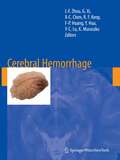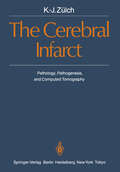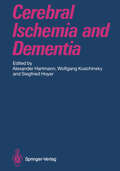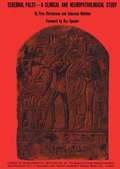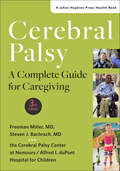- Table View
- List View
Cerebral Energy Metabolism and Metabolic Encephalopathy
by D. W. McCandlesIn recent years, there has been rapid growth in knowledge pertaining to the nervous system. This has, in some measure, been due to the development and application of a number of techniques such as the 2-deoxyglucose method and microchemical methods for measuring metabolites and regional cerebral blood flow. Data from the application of these techniques are just beginning to be collected, and the next few years promise to bring many new and exciting findings. The study of energy metabolism in brain is particularly interesting due to the fact that although the brain has scant energy reserves (as compared with the liver), it has one of the highest metabolic rates in the body. Recent studies from several laboratories have shown a surprising divergence of re sponses to metabolic insult in different areas of brain. In this regard, the cer ebellum, for example, may have metabolic features which are uniqve from those of any other region. The high-energy phosphate compounds ATP and phos phocreatine, supplied by the oxidative metabolism of glucose, are necessary for normal cerebral functions such as the maintenance of membrane potentials, transmission of impulses, and synthetic processes. Interruption of substrate or "poisoning" of the system by a variety of means lead to a rapid change in cellular energetics, and ultimately cell death. From the clinical standpoint, an interesting feature of metabolic encephalopathy is that in many cases, early diagnosis and treatment may result in a rapid reversal of symptoms.
Cerebral Hemorrhage (Acta Neurochirurgica Supplement #105)
by Liang-Fu Zhou Guohua Xi Xian-Cheng Chen Richard F. Keep Feng-Ping Huang Ya Hua Yi-Cheng Lu Karin MuraszkoCerebral hemorrhage is a common and often fatal subtype of stroke. while in the past it has received relatively little attention compared to ischemic stroke, there have been major advances in our understanding of this devastating form of stroke. The papers by world experts cover the field from molecular biology to clinical trials.
Cerebral Ischaemia: A Neuroradiological Study
by Jacques BoriesNumerous meetings have been devoted to cerebral The angiographic study specifies the indications vascular accidents during the last few years. Never of angiography in the study of cerebral ischemia, and theless our experience at La Salpetriere shows that the techniques to be used. It shows the main etiologic cerebral infarcts are not always well explored. Indi aspects. Because of the important place of vascular cations for angiography today, as well as the main surgery today, it seemed necessary to show also the CT aspects during the evolution of ischemia seem main post operative angiographic aspects. not to be always well known by radiologists. We After CT and angiography, some pages are re therefore thought it useful to have a special issue de served to more modem techniques: positron emis voted to cerebral ischemia; this is also the reason sion tomography which will perhaps allow us to bet why this special issue looks more like a thoroughly ter understand the pathophysiological signification worked out study than one exclusively devoted to a of imaging and magnetic resonance imaging, which limited number of scientific papers. will perhaps allow us to detect ischemic edema in the After a brief clinical and pathophysiological ap reversible stage, prior to frank infarction.
Cerebral Ischemia
by Werner Hacke Michael Hennerici Herman J. Gelmers Günter KrämerDespite a worldwide reduction in its incidence, stroke remains one of the most common diseases generally and the most important cause of premature and persistent disability in the industrialized countries. The most frequent cause of stroke is a localized disturbance of cerebral circulation, i.e., cerebral ischemia. Less common are spon taneous intracerebral and subarachnoid hemorrhages and sinus ve nous thromboses. The introduction of new diagnostic procedures such as cranial computed tomography, magnetic resonance imaging, digi tal subtraction radiologic techniques, and various ultrasound tech niques has led to impressive advances in the diagnosis of stroke. Through the planned application of these techniques, it is even possible to identify the pathogenetic mechanisms underlying focal cerebral ischemia in humans. However, these diagnostic advances have made the gap between diagnostic accuracy and therapeutic implications even greater than before. This fact can be easily explained. In the past, therapeutic studies had to be based on the symptoms and temporal aspects of stroke; it was impossible for early investigations to consider the various pathogeneses of cerebral ischemia. Inevitably, stroke patients were treated as suffering from a uniform disease.
Cerebral Ischemia: Molecular and Cellular Pathophysiology (Contemporary Neuroscience)
by Wolfgang WalzThe human brain represents about 2% of the body weight, yet it accounts for approximately 20% of aerobic metabolism. This high dependency on energy-consuming processes is mainly caused by the active transport of ions, which is necessary to compensate for the transmembrane ion currents that are part ofthe complex signaling processes in the brain. Ninety-five percent ofthe brain's ATP is derived from mitochondrial oxidative phosphorylation. Since that organ' s storage capacity for oxygen is minimal, any interruption of oxygen delivery to brain cells willlead to changes in membrane excitability and, there fore, to disruption of neuronal signaling within seconds. It seems that mamma lian brain is especially vulnerable to such an interruption, since oxygen deprivation leads to activation of ion channel mechanisms in neurons that impair their communications. Thus, the function of the brain as a coordinator of vital homeostatic reflexes, and complex body reactions to external challenges, depends critically on the rate of oxygen delivery and oxygen consumption. Oxygen delivery depends on two variables described in the Fick relation ship: volume flow rate ofblood and the arterial oxygen content. A reduction in either of these two variables will have serious effects on vital brain func tions. Reduction of arterial blood flow to the brain can be caused by cardiac arrest, shock, carotid occlusion, Of hypotension (global ischemia). Oxygen content is progressively decreased in asphyxia (including drowning).
Cerebral Ischemia and Basic Mechanisms
by Alexander Hartmann Frank Yatsu Wolfgang KuschinskyIn this volume, one of a series of monographs devoted to the problems of cerebral ischemia and related topics, we present the proceedings of an international conference on Cerebral Ischemia and Basic Mechanisms held in Bad Schachen/Lake Constance, Germany in June 1992. The enormous progress in research recently on the basic mechanisms associated with cerebral ischemia has provided greater insight into the pathophysiological mechanisms of reduced brain perfusion and decreased cerebral metabolism. The high technology instrumentation used to unravel the intricacies of cerebral blood flow and metabolism includes positron emission tomography and magnetic resonance imaging. A description of sophisticated neurophysiological techniques will give the reader insight into new models of reversible and irreversible tissue damage and changes at the molecular level have been described. The therapeutic approaches which have developed from this re search have been or will be used in clinical trials and will open new avenues in the treatment of stroke. The organizers of the meeting would like to thank the advisory board for its helpful suggestions and the Deutsche Forschungsgemeinschaft and other sponsors for their important support.
Cerebral Ischemia and Calcium
by Alexander Hartmann Wolfgang KuschinskyAlthough many books deal with isolated problems of calcium disturbance in relation to cardiac and cerebral function, this is the first to focus specifically on calcium metabolism and cerebral ischemia. Internationally acknowledged experts present recent data and new concepts in an interdisciplinary approach to the subject. They examine basic information on the pathophysiology of cellular events, the damage caused by excitotoxic substances, and the effects of calcium antagonistic drugs as measured in experimental animals. These contributions may help lead to possible therapeutic interference for the prevention of calcium imbalance.
Cerebral Ischemia and Dementia
by Alexander Hartmann, Wolfgang Kuschinsky and Siegfried HoyerIn contrast to dementia of the Alzheimer type, the subject of dementia subsequent to cerebral ischemia has been discussed rather rarely. Now this book provides a summary of the brain morphology, neurochemistry and clinical aspects of dementia subsequent to cerebral ischemia. The contributions discuss the similarities and differences between the two predominant dementia types. The broad range of aspects cover 1) the morphology and morphobiology of brain tissue during aging and under the two pathological condi- tions, 2) the neuropathochemistry of post mortem brain tissue of patients as well as brain tissue from experimental animals, 3) CSF changes during aging and in dementia states and 4) clinical research, mainly using brain imaging tech- niques to differentiate between dementia types and to find a basis for rational therapeutic approaches.
Cerebral Ischemia and Hemorheology
This book contains the scientific contributions presented during the inter national symposium "Cerebral Ischemia and Hemorheology", held in Germany in June 1987. The purpose of the symposium was to bring together experts in the fields of cerebral circulation and rheology, in order to increase the knowl edge and scope of both of these groups by making the members of each group more aware of work in the complementary field. The organizers hoped to stimulate the discussion between both groups and to reach adecision about whether the alteration of rheologie parameters might change the course and fate of cerebral ischemia. The contributions also report on clinical and basic studies pertinent to the topic of the symposium. The book is a comprehensive description of the state of the art wich may help to define what is known and to find new strategies to better und erstand metabolie, circulatory, and rheologie changes during cerebral ischemia. The selection of papers for publication was the task of the advisory board. The editors would like to thank the members for their critical analyses and suggestions; they are: Shu Chien, New York; F. Gotoh, Tokio; K.A. Hossmann, Cologne; G. Schmid-Schönbein, Aachen; L. Symon, London; and F. Yatsu, Houston. Bonn ALEXANDER HARTMANN WOLFGANG KUSCHINSKY Contents Local Control ofthe Cerebral Circulation. W. KUSCHINSKY (With 2 Figures) . . . . . . . . . . . . . . . . . .
Cerebral Ischemic Reperfusion Injuries: Bench Research and Clinical Implications (Springer Series in Translational Stroke Research)
by Weijian Jiang Wengui Yu Yan Qu Zhongsong Shi Benyan Luo John H. ZhangThis volume is focused on subjects related to cerebral ischemia and reperfusion injuries after acute stroke. All chapters are selected from the Sixth Elite Stroke meeting named Pangu Stroke Conference and written by members of world leading laboratories of stroke studies. The contents cover both clinical and bench studies, from basic components of cerebral arterial system to clinical reperfusion injury cases, from reperfusion caused programmed cell death and astrocyte activation to oxidative stress and nitric oxide after reperfusion, from extracellular matrix and inflammation to a role of diabetes after reperfusion, from small artery disorders to collateral circulation and blood pressure control after reperfusion. Wei-Jian Jiang, Chairman of New Era Stroke Care and Research Institute of PLA Rocket Force General Hospital, Beijing, China. Wengui Yu, Professor and Director of Comprehensive Stroke & Cerebrovascular Center, University of California, Irvine Yan Qu, Professor and Director of Neurosurgery at the Second Affiliated Hospital of Air Force Medical University, Xi’an, China. Zhongsong Shi, Professor of Neurosurgery at Sun Yat-sen Memorial Hospital, Sun Yat-sen University, Guangzhou, China. Ben-yan Luo, Professor and Chair of Neurology at the First Affiliated Hospital of Zhejiang University. John H. Zhang, Professor of Anesthesiology and Physiology at Loma Linda University School of Medicine, Loma Linda, CA, USA.
Cerebral Localization: An Otfrid Foerster Symposium
by K. J. Zülch, O. Creutzfeldt and G. C. GalbraithThe demonstration of the basic brain mechanism through studying the partially commissure-sectioned case appears to be a most prom ising enterprise. The work with animals of HAMILTON and others in elucidating psychological brain process heretofore not imagined are mere indications of what the potential seems to be. Study of the partially disconnected patient seems equally revealing and productive in showing how many high level cognitive activities are managed in the cerebral flow of information. With respect to the issue of localization of function, it would seem clear that those cerebral areas clearly involved in the im mediate processing of raw sensory information can be selectively and specifically isolated and disconnected. In other words, the informational products of the long axonal type cells of Golgi, which MARCUS JACOBSON claims are the brain cells under strict genetic control, can be isolated, whereas the products of more complex and integrative mental activities which are managed by the more mutable Golgi type II cells do not seem to be so spec ifically disposed. Thus, these data suggest the lateralized spe cialities of the various left and right brain areas can make their contribution to the cerebral activities of the opposite hemisphere through almost any callosal area regardless of its size and loca tion. Indeed, this interpretation suggests to me that the long standing issue of the extent of localization could be better un derstood by considering the dichotomy in genetic specification as offered by HIRSCH and JACOBSON (1974).
The Cerebral Microvasculature: Investigation of the Blood-Brain Barrier (Advances in Experimental Medicine and Biology #131)
by Howard M. EisenbergAs traced by Uichael Bradbury in his recently published monograph, The Concept of a BZood-Brain Barrier, the idea of a scientific challenge is just about as old as the twentieth century. Curiously, it remains undefined. Is it a structure or structures as some use the term, or is it a reciprocal per meability, a force-flow relationship, as do others, or is it a group of processes, some more specialized than others? Depend ing upon the observer, the method, and what is observed, it seems to be each of these or all. This Symposium takes as its focus of interest the micro vasculature of the brain and includes considerations of blood flow, the properties of vessel walls and the control of flow and permeability. In addition perturbations that change the characteristics of the flow of materials are given attention. By changing the usual focus of interest, the organizers, Drs. Suddith and Eisenberg, have given a fresh outlook to the subject and now, by publication of the Proceedings, have arranged for wide availability of these interesting papers. Keasley Welch v PREFACE A symposium on the cerebral microvasculature and its function in the blood-brain barrier was held at The University of Texas Medical Branch, Galveston, in the summer of 1979. Investigators from the United States and Europe met to discuss their recent work.
Cerebral Monitoring in the Operating Room and the Intensive Care Unit (Developments in Critical Care Medicine and Anaesthesiology #22)
by Enno FreyeIn spite of today's increasing body of knowledge in regard to central nervous func tion and/or the mode of action of centrally active compounds, little is done to monitor those patients which are at risk of cerebral lesions either in the OR or in the ICU. Due to the inconsistency of reports regarding the application and the benefits computerized EEG and/or evoked potential monitoring will bring to the clinician, physicians still are reluctant to get involved with a technique, which they think, will have little or no effect on the outcome of a patients well being. However, due to the development in computer technology, data acquisition and comprehension, it now is possible to monitor such a viable organ as the Central Nervous System (CNS) on a routine base without being a specialist in neurology or electroencephalography. Thus, the book is intended to guide the clinician to use BEG and evoked potential monitoring in a day to day situation, without going too deep into technical details. As an improvement of cerebral care is needed, various representative cases underline the interpretation of EEG power spectra and evoked potential changes in regard to the underlying clinical situation. It is hoped that this book will serve as a guide to anyone who considers cerebral monitoring a necessity in today's patient care. This may be the anesthesiologist, the intensive care therapist, the nurse anesthetist as well as the medical personnel in the lCU setting.
Cerebral Monitoring in the OR and ICU
by Enno FreyeThis comprehensive volume will serve as a complete guide to the clinical application of computer assisted systems in monitoring central nervous functions both in the OR and ICU. It presents practical guidelines and therapeutic indications for computerized EEG and Somatosensory Evoked Potential (SSEP) monitoring for the experienced user as well as the novice, leading the newcomer step-by-step to a level of advanced monitoring. Basic procedures and data handling are explained in a user-friendly and practical way. The book also describes what cerebral monitoring can do and what its limitations are. In addition, proper selection of the available monitoring devices, set-up procedures, the technique of electrode placement, trouble shooting and data interpretation are fully covered. Various typical cases underline how EEG power spectra and evoked potential changes are interpreted, how they are used in the light of other variables being measured how they can serve to get a deeper insight into the underlying clinical situation. In this respect representative and color illustrated examples further emphasize the link between this book and clinical practice.
Cerebral Palsy: A Clinical and Neuropathological Study
by Erna Christensen Johannes C. MelchiorCerebral Palsy: A Clinical and Neuropathological Study is an account of a detailed study in which obstetrical, neonatal and neurological investigations on a large group of patients are presented with full neuropathological data found at subsequent necropsy. The book discusses the general autopsy findings and neuropathological techniques; as well as neuropathological findings in the different clinical entities. The text also describes the neuropathological findings and classification; progressive encephalopathies; and epilepsy. Neurologists will find the book invaluable.
Cerebral Palsy: A Practical Guide for Rehabilitation Professionals
by Psiche Giannoni Liliana ZerbinoThis book helps rehabilitators and caregivers understand the multifaceted needs of children with cerebral palsy or other neuromotor impairments in order to plan and implement an effective treatment regimen. Drawing on the authors’ extensive experience spanning several decades, it addresses the sensitive challenge of rehabilitation, which cannot and must not be confined by the rigid schemes of established schools. In particular, the book provides numerous practical suggestions, intended to guide the reader through correct clinical reasoning, setting goals and subsequent treatment. Furthermore, it includes chapters on evaluating and treating the upper limbs, feeding and communication problems, as well as on the care of soft tissues and the management of the visual difficulties in these children.The book is a valuable resource for physiotherapists, occupational therapists, speech therapists and other caregivers.
Cerebral Palsy: Perspective and Clinical Relation to Perinatal Complications/Events in Japan
by Yoshio MatsudaThis edited book presents the latest information on epidemiology, pathophysiology, diagnosis, and some current topics covering all aspects of cerebral palsy. It offers a novel interpretation of a group of lifelong movement disorders, which now is an accepted notion that the causes of cerebral palsy are multifactorial rather than birth asphyxia. The book is organized into three parts, and it begins with illustrating the perspective of the disease. Then focuses on the relationship between clinical features of perinatal complications/events and cerebral palsy. The last part offers a hot topic of the prevention such as hypothermia, neuroprotection, and stem cell transfer. Since there is no cure for this congenital motor disability of cerebral origin, effective strategies for primary prevention are highly desirable. Effective strategies require an understanding of causal pathways and the Editor wishes to disseminate the experience and knowledge through this comprehensive volume to the readers.Cerebral Palsy - Perspective and Clinical Relation to Perinatal Complications/Events is a valuable source for clinicians, researchers, and medical staff who deal with the management of pregnancy and delivery. It also attracts clinicians worldwide who are interested in recent updates on this field.
Cerebral Palsy
by Freeman MillerDr. Miller’s valuable resource helps members of the medical team navigate the complexity of cerebral palsy care by explaining unfamiliar treatments that fall outside of their own disciplines. Readers also benefit from a review of current practices in their own fields. Includes recommended treatment algorithms and is designed to help improve decision making. Written in a very conversational style and illustrated with lots of color the volume provides rehabilitational (part 1) and surgical aspects (part 2). Accomplished by a CD-ROM which provides lots of case studies - including walking analysis. The most comprehensive title on this topic written by a leading expert.
Cerebral Palsy: A Complete Guide for Caregiving (A Johns Hopkins Press Health Book)
by Freeman Miller Steven J. BachrachWhen their child has cerebral palsy, parents need answers. They seek up-to-date advice they can count on to make sure their child has the best possible health and well-being. For three editions now, a team of experts associated with the Cerebral Palsy Program at the Alfred I. duPont Hospital for Children have shared vital information through this authoritative resource for parents, who will turn to it time and time again as their child grows.The new edition is thoroughly revised to incorporate the latest medical thinking, including advances in diagnosis, treatment, and terminology. Every chapter includes new content on topics ranging from genetics to pain, temperature control, palliative care, why growth suppression is sometimes recommended, the Affordable Care Act, and how to make it easier for siblings to cope. Chapter 8 has been entirely rewritten to better help adolescents prepare for the transition to adulthood. New classification systems, such as the gross motor function classification system and the Functional Mobility System, are described and explained. And a number of emerging therapiesâ€�including marijuana oil, cord blood transfusion, deep brain stimulation, epilepsy surgery, and growing spinal rodsâ€�are explored.Intended for parents, grandparents, teachers, therapists, and others who care for and about people with cerebral palsy and cerebral palsylike conditions, this is an essential and compassionate guide.Key Features:• Detailed descriptions of specific patterns of involvement (hemiplegia, diplegia, quadriplegia)• Explanations of the medical and psychosocial implications of CP• Photographs and drawings that complement the text• Practical advice about caregiving, from nutrition to mobility • An illustrated encyclopedia that defines and describes terms, diagnoses, medical and surgical procedures, and orthopedic and other assistive devices• Lists of resources and recommended reading, which include a number of online sources
Cerebral Palsy: A Complete Guide for Caregiving (A Johns Hopkins Press Health Book)
by Freeman Miller Steven J. BachrachWhen their child has cerebral palsy, parents need answers. They seek up-to-date advice they can count on to make sure their child has the best possible health and well-being. For three editions now, a team of experts associated with the Cerebral Palsy Program at the Alfred I. duPont Hospital for Children have shared vital information through this authoritative resource for parents, who will turn to it time and time again as their child grows.The new edition is thoroughly revised to incorporate the latest medical thinking, including advances in diagnosis, treatment, and terminology. Every chapter includes new content on topics ranging from genetics to pain, temperature control, palliative care, why growth suppression is sometimes recommended, the Affordable Care Act, and how to make it easier for siblings to cope. Chapter 8 has been entirely rewritten to better help adolescents prepare for the transition to adulthood. New classification systems, such as the gross motor function classification system and the Functional Mobility System, are described and explained. And a number of emerging therapiesâ€�including marijuana oil, cord blood transfusion, deep brain stimulation, epilepsy surgery, and growing spinal rodsâ€�are explored.Intended for parents, grandparents, teachers, therapists, and others who care for and about people with cerebral palsy and cerebral palsylike conditions, this is an essential and compassionate guide.Key Features:• Detailed descriptions of specific patterns of involvement (hemiplegia, diplegia, quadriplegia)• Explanations of the medical and psychosocial implications of CP• Photographs and drawings that complement the text• Practical advice about caregiving, from nutrition to mobility • An illustrated encyclopedia that defines and describes terms, diagnoses, medical and surgical procedures, and orthopedic and other assistive devices• Lists of resources and recommended reading, which include a number of online sources
Cerebral Palsy: A Complete Guide For Caregiving (Johns Hopkins Press Health Bks.)
by Freeman Miller Steven Bachrach Nancy Lennon Margaret E. O’NeilCerebral Palsy: A Multidisciplinary Approach (Thieme Publishers Series)
by Christos P. PanteliadisThis third edition systematically reviews recent developments in the diagnosis and evidence-based treatment of cerebral palsy, a consequence of foetal and early infant brain damage resulting in lifelong disabilities with a range of clinical characteristics. The first part discusses the definition, aetiology, classification, imaging and neuropathology, while the second focuses on the management of the individual challenges that children with cerebral palsy face, such as spasticity, dyskinesia, feeding problems and scoliosis. Based on the diverse characteristics of cerebral palsy, children require care from various specialists, including neuro-paediatricians, orthopaedists, psychologists, epidemiologists, physiotherapists and occupational therapists. This work was written by an international team of such specialists, providing a comprehensive mix of perspectives and expertise.
Cerebral Palsy in Infancy E-Book: targeted activity to optimize early growth and development
by Roberta B. ShepherdCerebral Palsy in Infancy is a thought-provoking book which introduces a new way of thinking on the development and use of interventions. Relevant to current practice, it advocates early, targeted activity that is focused on increasing muscle activation, training basic actions and minimizing (or preventing) mal-adaptive changes to muscle morphology and function. The authors present recent scientific findings in brain science, movement sciences (developmental biomechanics, motor control mechanisms, motor learning, exercise science) and muscle biology. This knowledge provides the rationale for active intervention, underpinning the need for an early referral to appropriate services. The book features methods for promoting relatively intensive physical activity in young infants without placing a burden on parents which include assistive technologies such as robotics, electronic bilateral limb trainers and baby treadmills. Cerebral Palsy in Infancy begins by specifying the guidelines for training and exercise, outlining the rationale for such intervention. It goes on to cover the fundamentals of neuromotor plasticity and the development and negative effects of limited motor activity on brain organization and corticospinal tract development. Neuromuscular adaptations to impairments and inactivity are discussed along with the General Movement assessment that can provide early diagnosis and prognosis, facilitating very early referral from paediatric specialists to training programs. The book ends with a section featuring various methods of training with the emphasis on preventing/minimizing muscle contracture, stimulating biomechanically critical muscle activity and joint movement. An ideal clinical reference for those working to improve the lives of infants suffering from cerebral palsy. CONTRIBUTORS: Adel Abdullah Alhusaini (Saudi Arabia); David I. Anderson (USA); Nicolas Bayle (France); Roslyn Boyd (Australia); Giovanni Cioni (Italy); Diane L. Damiano (USA); Janet Eyre (UK); Linda Fetters (USA); Mary Galea (Australia); Andrew M Gordon (USA); Martin Gough (UK); Richard L Lieber (USA); Jens Bo Nielsen (Denmark); Micah Perez (Australia); Caroline Teulier (France).conceived and edited by Roberta Shepherd with contributions from internationally renowned expert clinicians and researchersdiscusses new research and new evidence-based treatment interventionsshows how to organize very early and intensive physical activity in young infants to stimulate motor development and growththerapies include the specificity of training and exercise, with emphasis on promoting muscle activity and preventing contracture by active instead of passive stretchingmethods include new interactive technologies in enhancing home-based training sessions carried out by the infant’s familyextensive referencing in each chapter for further studychapters feature "Annotations" which illustrate scientific findings

